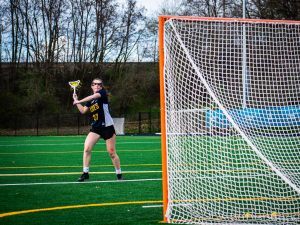When Whitman students learn about the history of Japanese sculpture, or enroll in a tea ceremony course, they don’t just look at pictures in a book or trek to the library. They use genuine historical artifacts, many of which haven’t had a secure and accessible home at Whitman until now.
A gift made to the college in 1984 by Seafirst Bank, the Thomas P. Davis collection of Asian art now has a permanent home in Olin East. Lovers of historical art from both the campus and the community can now view pieces on a regular basis. The collection is comprised of statues, ceramics, puppet heads, screens and hanging scrolls–some of which date from the 15th century.
Associated Kyoto Program Chair Akira Takemoto designed Chikurakken (Enjoying the Bamboo Room), which is his Yabanouchi Tea Room and the Asian Studies Art Gallery, and acts as a type of steward to the college’s Asian art collection.
“We accepted this collection [in 1984] with the promise that we would exhibit it, but [that was] easier said than done,” said Takemoto.
The lack of storage space led to the collection’s storage in various places across campus, boxed and separated. The college did a series of exhibits in the mid-1990s to try to fulfill the intent of the donors, but they were by necessity temporary. That problem was finally addressed in 2009 and 2010 with the completion of the storage space and Chikurakken.
“My thought was if you’re going to store it it’d be important nearby or as close as possible to have a space to display it,” said Takemoto.
He rotates displays of the pieces in the gallery and brings out pieces for his classes to look at when studying particular time periods and themes. The current theme, for example, is the significance of the Ordinary Mind, the mind that celebrates the everyday. Takemoto will subtly change the room and will replace one art piece for another to see what students notice.
“This room is asking us to put the ‘matters of consequence’ to the side and see what we discover. When you walk in here we’re not asking you to know things, we’re asking you to notice,” he said.
It seems to be working. Senior Raisa Stebbins, who is taking the tea ceremony course, appreciates seeing and using new and different pieces from the collection.
“Professor Takemoto is really good about rotating them, so while we get to know things really well there’s always something new and surprising that will show up,” Stebbins said.
Students also benefit from the exhibition of the pieces in ways that a conventional museum setting would not allow. The statues on display now, for example, go back to the 8th century; because they’re Buddhist statues, Takemoto said, the best way to exhibit them is how they would have been originally used in a temple setting. He led his students inside and had a mini-ceremony with them.
“It’s really astounding to be able to use these things,” said Stebbins.
The collection in this way helps to fulfill Takemoto’s goals for the Chikurakken.
“My intent is to create a space where people come in here … and there’ll be a different feeling to this space, it’s not just a classroom, and it’s not just a performance space and it’s not just an exhibition space, it’s all of those,” he said.
The extensive Davis collection, amassed by a bank executive stationed in Tokyo, transferred to Seafirst Bank in Seattle, gifted to Whitman and stored for 20 years is now viewed and used on a regular basis by faculty and students alike.









